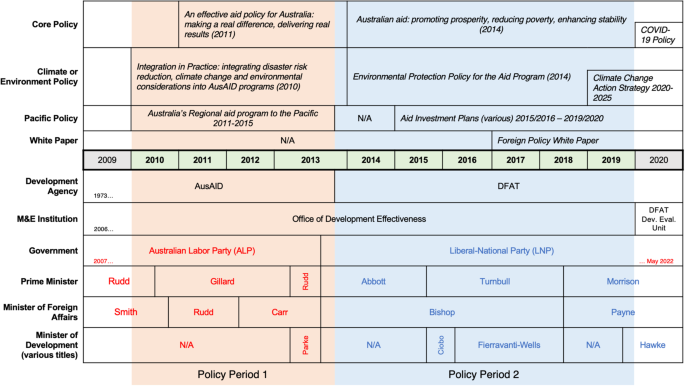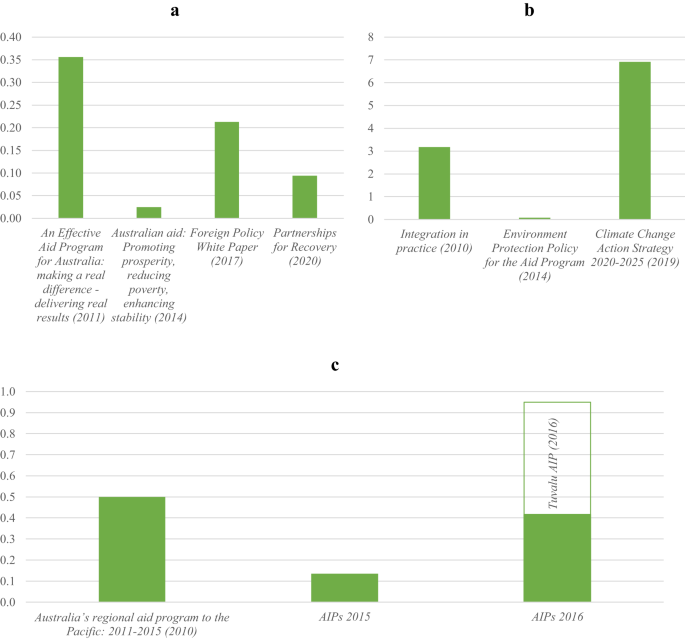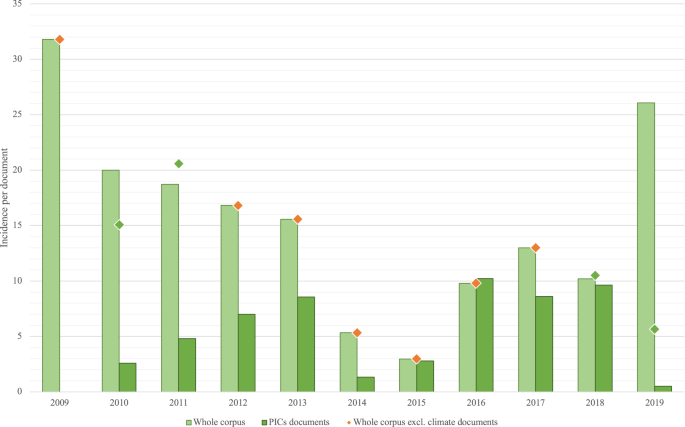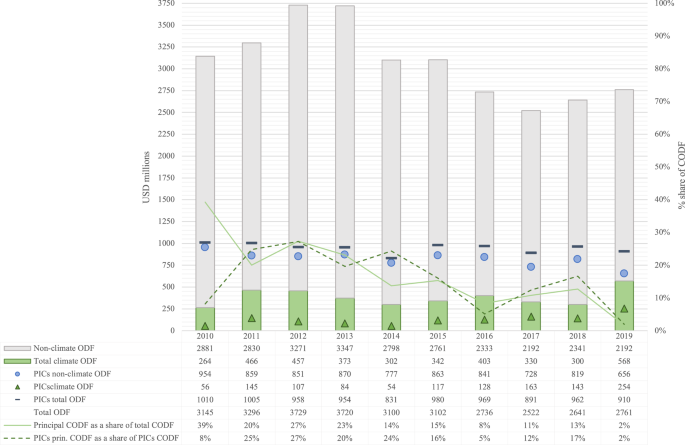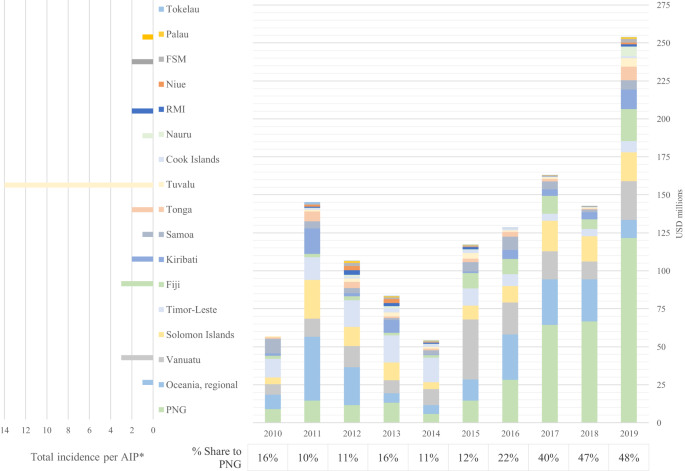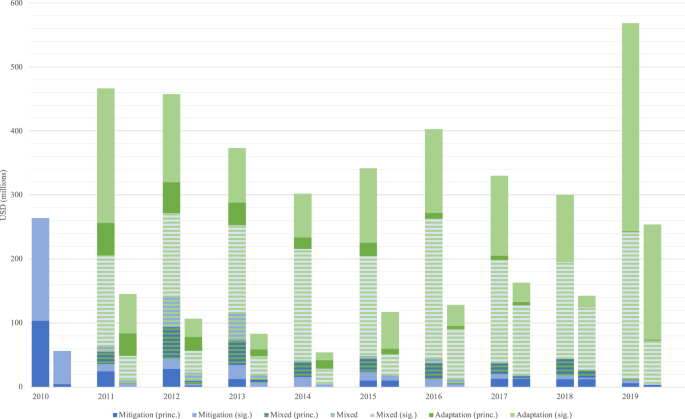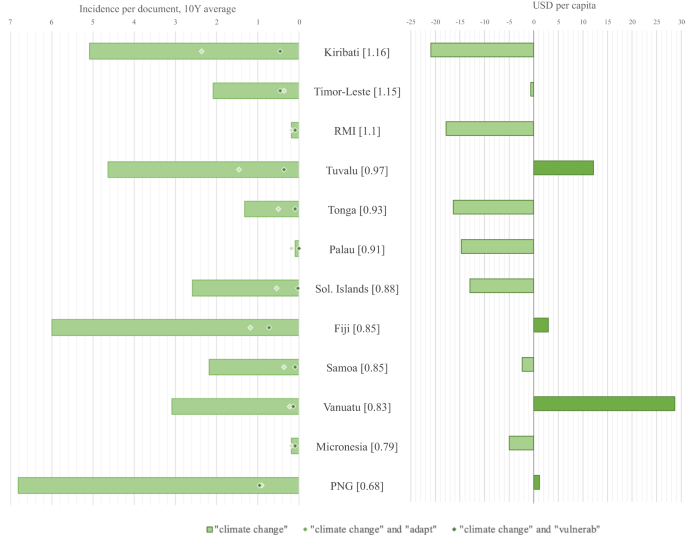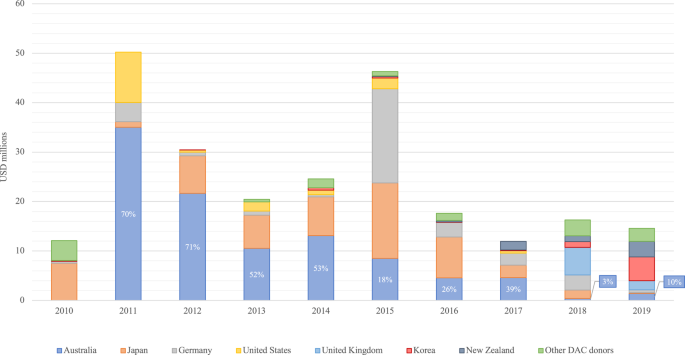Abstract
Pacific Island actors have long called for climate justice in the international climate regime, particularly in the form of financial support. While climate finance can be conceptualised as a mechanism of climate justice, the extent to which climate finance does indeed contribute to climate justice is contested. We explore these contestations by looking at Australia’s development programme in the Pacific between 2010 and 2019, examining both policy documents and climate finance flows. This analysis is conducted through a climate justice lens that we conceptualise as consisting of three dimensions: adequacy, additionality, and predictability; balance between adaptation and mitigation and priority provision of adaptation finance to vulnerable recipients; and donor coordination. Our analysis shows that Australian public climate finance has not acted as a mechanism of climate justice according to our criteria in the period studied, even if does meet some criteria of climate justice. From a justice perspective, Australia has approached climate change inconsistently and at times incoherently across its development program in Pacific Island countries. These results provide important lessons for Australia’s approach going forward, under a new government and a new development policy framework.
Similar content being viewed by others
Introduction
The notion of ‘climate justice’ is central to the international climate regime—from advocacy, to negotiations, to the provision of climate finance. Climate justice highlights the uneven contributions to anthropogenic climate change across countries, communities and individuals, and the inequalities in how these are affected by, and able to address, its consequences1,2,3. In practice, climate justice means first and foremost that industrialised countries—whose greenhouse gas (GHG) emissions have caused the climate crisis in the first place—must drastically reduce their emissions and limit further increases in global temperature.
Climate justice is key to Pacific Island countries (PICs), as their GHG emissions are negligible on a global scale while they are among the first and worst affected4. Because the climate has already begun changing, with considerable variation in incidence and impact of the consequences across the world, climate justice also means supporting vulnerable countries like PICs to adapt to climate impacts5.
The international climate regime has, in principle, recognised the responsibility of industrialised countries to provide financial and technical assistance since the 1992 UN Framework Convention on Climate Change (UNFCCC) and stipulated a concrete collective goal of USD 100 billion annually in the 2009 Copenhagen Accord. While climate finance remains a central pillar of the climate regime today, it is also highly contested. Among other things, tensions arise from questions around what counts as climate finance, how it is to be distributed among recipients, the extent to which it is additional to regular development finance, whether provision concedes liability, and who decides on these questions5,6,7. Indeed, climate finance may reify rather than rectify existing injustices and inequalities, such as when externally funded projects support those that are already relatively well-off or when climate finance is provided through loans, further indebting recipients5.
Climate finance and climate justice are clearly linked in multiple and complex ways. In the context of international cooperation and redistribution of resources, climate finance can contribute to climate justice—if and when it meets certain criteria. To better understand the climate justice-development nexus, we establish a set of criteria that we argue climate finance should fulfil to be a mechanism of climate justice in this context. We then examine Australia’s development assistance to the Pacific against these criteria, focusing on both Australia’s development discourse as documented in its development cooperation policy documents, and Australia’s development finance flows to the Pacific as reported to the OECD Creditor Reporting System (CRS) between 2010 and 2019. Australia’s development cooperation in the Pacific is particularly suitable for such an exercise as Australia is one of the largest contributors to GHG emissions worldwide, and a major provider of development assistance in the Pacific. At the same time, PICs are among the most affected by climate change, are major recipients of climate finance per capita and are strong proponents of climate justice. Our analysis suggests that Australia’s approach to climate finance in the Pacific does not reflect our criteria of climate justice—although recent changes in domestic politics and policy may lead Australia on a path that is more compatible with climate justice.
In the next section, we discuss the literature on climate finance and climate justice, as well as the specific case of Australia and PICs. We then turn to our conceptual framework and describe our criteria of just climate finance before presenting our results and discussion. Our methodological approach is explained at the end of the article.
Literature and analytical framework
Climate finance has been built into the climate regime since 1992, but it was in 2009 that it took centre stage in negotiations7,8. While COP15 in Copenhagen is widely considered a failure, the summit did, for the first time, result in quantified finance promises6: industrialised countries were to provide (USD) $30 billion in ‘fast-start finance’ between 2010 and 2012, and then scale this up to $100 billion per year by 2020. This finance was to be “new and additional, predictable and adequate”, come from a “variety of sources” and be balanced across mitigation and adaptation9. The 2010 Cancún Agreement and the 2015 Paris Agreement confirmed this commitment, with a new financial goal of at least $100 billion per annum to be agreed by 202510. Since COP27 in 2022, new funding arrangements are also envisaged for loss and damage11.
While climate finance commitments are central to the climate regime and supposedly help to build and maintain trust, especially between ‘polluters’ and ‘victims’ of climate change12,13, commitments are (deliberately) vague, open to interpretation, and not always honoured7. For example, what counts toward the $100 billion was never clearly defined, nor to what climate finance would need to be new and additional14, thus making it difficult to objectively measure and track finance flows6,15. Even according to the most optimistic numbers from the OECD, donors had only mobilised $83.3 billion in 202016. More critical voices provide much lower estimates of as little as $23 billion6,17.
Regardless of its actual volume, climate finance does not meet demand7. It is difficult, if not impossible, to put a price tag on needs, especially when also considering non-material costs, losses, and damages. Yet it is clear that developing countries need trillions, not billions, to decarbonise their economies and adjust to the effects of climate change6,18,19. The gap is largest for adaptation, which has received only about 25% of support16, despite its importance for many developing countries, particularly the most vulnerable and least emitting like PICs6.
PICs are overall highly aid-dependent20. While total climate finance to the Pacific is fairly small in comparison to other regions, PICs are amongst the highest recipients of climate finance per capita, at least for adaptation21,22. There are, however, large differences within the region, and it seems to be population size rather than the vulnerability that explains high per capita numbers22,23,24.
Australia is the largest development finance provider in the region, both for development and climate projects22. Concurrently, it is also the largest GHG emitter in the region and has one of the highest per capita emissions worldwide25. While Australian climate policies have fluctuated with changes in government26, Australia has overall underperformed on climate action according to a variety of metrics27,28. Fluctuations also mark Australia’s provision of climate finance26, which has remained below its ‘fair share’, regardless of how that ‘fair share’ was computed27,29,30,31.
Yet even high levels of climate finance do not automatically translate to climate justice5. We argue instead that climate finance needs to meet several essential (and internationally agreed) conditions to be a mechanism of climate justice. Just climate finance needs to be (i) adequate, additional, and predictable, as well as (ii) balanced between adaptation and mitigation, prioritising adaptation for vulnerable recipients mainly through grants. A step further, we also argue that (iii) donor coordination is a critical enabler of justness in climate finance. Here, we explain these conditions in more detail and why we consider them essential for climate justice.
First, adaptation and mitigation are costly, and public climate finance flows are insufficient to cover needs. Even if flows are inherently inadequate, we consider ‘adequacy’ within the framework of the $100 billion goal to mean that flows need to at least represent a country’s ‘fair share’32 and follow an upwards trend as evidence of scaling up to meet commitments. Climate finance also needs to represent new and additional resources since its purpose is to help recipients deal with the additional burden of climate change7. This means it should not replace ‘regular’ development finance, and that it should be principally targeted rather than mainstreamed across existing finance. Climate finance should also favour grants, as grants better reflect the nature of climate change as an additional burden caused by others, do not worsen countries’ indebtedness, and address the notion of ‘climate debt’5,7,33. We also include predictability, as aid volatility has negative impacts on effectiveness and makes it difficult for PICs to properly plan and implement climate action in the long term32. Adequacy, additionality and predictability are agreed to in climate agreements and have been categorised as ‘crucial for enhancing the effectiveness, fairness and legitimacy of the climate finance system and the global climate regime as a whole’26.
Second, adaptation is underfunded compared to mitigation. While implementation of an agreed ‘balance’—assumedly, a 50:50 distribution—would be an improvement over current flows, we argue that for many recipients, finance flows need to first and foremost support adaptation, in line with the recipient’s demands6. This is especially so in vulnerable countries like PICs, where emissions are low and vulnerability high. These countries, as small island developing states (SIDS), are to be prioritised alongside least developed countries (LDCs), the two groups of countries considered ‘particularly vulnerable’ in climate agreements. But levels of vulnerability vary even within SIDS and LDCs, as demonstrated by vulnerability indicators34,35.
Third and finally, given the collective nature of the $100 billion goal, donors need to contribute their fair share, and coordinate their provision of climate finance. While the Green Climate Fund was established as a centralising mechanism for climate finance provision, most public climate finance is still provided bilaterally36. In light of donor comparative advantage, it is reasonable that certain donors would concentrate their development programs towards particular recipients or approaches. However, as donors collectively committed to providing $100 billion a year according to a variety of characteristics as outlined above, there is a clear need to coordinate flows accordingly—for example, ensuring that any reduction in adaptation finance to vulnerable recipients from one donor is compensated by another, or that those donors with comparative technical capacity in mitigation projects are counterweighted by other donors providing adaptation finance—still bearing in mind the notion of fair share. This latter notion can be linked to a variety of characteristics, such as relative responsibility (e.g., historical emissions) or capacity (e.g., gross national income (GNI))27,29,30,31.
Our framework to assess climate finance as climate justice, as summarised in Table 1, is inherently high-level. In the interest of scope, it does not address accessibility of finance (another challenge for PICs) or the actual implementation or effectiveness of projects, nor does it consider non-economic impacts, losses, or damages. It also treats climate finance as conceptually distinct from development finance for accounting purposes—though in practice, mainstreaming is accepted good practice given the interconnected nature of development and climate activities and the co-benefits associated37. None of the characteristics outlined above preclude the need for enhanced climate finance of other kinds. However, within the bounds of the $100 billion commitment—explicitly framed as a transfer of money from developed to developing countries—providing and tracking climate finance in a just way in the first instance is critical to maintaining its legitimacy within the regime, responding to the needs and demands of vulnerable groups, and avoiding adverse or unjust flow-on effects like indebtedness or intensified inequalities.
Results
Setting the scene: discourse trends across governance, policy, and institutional shifts
Between 2010 and 2019 there were several changes of government in Australia (Fig. 1). In 2014, Australia’s development agency of 40 years, AusAID, was absorbed into the Department of Foreign Affairs and Trade (DFAT). This unanticipated merger took place two months after the election of the Abbott Liberal-National (LNP) government, ostensibly to allow ‘the aid and diplomatic arms of Australia’s international policy agenda to be more closely aligned’38. The jobs of 500 DFAT and AusAID workers were targeted for redundancy or attrition39 with a loss of institutional knowledge that included loss of climate expertise40. Similarly, the Office of Development Effectiveness (ODE) was abolished in 2020, and replaced by a smaller dedicated internal department focused on project-level rather than larger strategic evaluations41,42.
Note: M&E: monitoring and evaluation; Dev. Eval.: Development Evaluation. In order, Prime Ministers were Kevin Rudd, Julia Gillard, Kevin Rudd, Tony Abbott, Malcolm Turnbull, and Scott Morrison; Ministers for Foreign Affairs were Stephen Smith, Kevin Rudd, Bob Carr, Julie Bishop, and Marise Payne; Ministers of Development (and the Pacific) were Melissa Parke, Steven Ciobbo, Concetta Fierravanti-Wells, and Alex Hawke. Policies are dated by date of publication to track discourse at time of publication. Source: Authors’ compilation.
Two overarching aid policies were released during, respectively, the Gilliard Labor and Abbott LNP periods, followed by a time-bound COVID-19 policy in the Morrison LNP period (2020) (Fig. 1). In addition to these ‘core’ policy documents, several climate-relevant policy and strategy documents were published: an integration policy (2010), an environmental protection policy (2014), and a Climate Change Action Strategy (CCAS) (2019) housed under the latter. The CCAS was developed following an apparent ‘renewed focus’ on climate change after the 2015 Paris Agreement, and an ODE climate evaluation recommending a strategy in 201840. The 2018 Development Assistance Committee (DAC) Peer Review of Australia also recommended mainstreaming and increasing climate and environmental ODA based on the absence of ‘a strategic approach to mainstreaming the environment and climate across the programme that is backed by sufficient capacity and resources, despite recognition that these issues are risks for security and prosperity in the Pacific’43. This was a backslide compared to the 2013 DAC Peer Review which had recommended continuing AusAID’s mainstreaming approach44.
Australia also published Pacific policy documents, including an AusAID regional policy for 2011–2015. In 2015 and 2016, a variety of Aid Investment Plans (AIPs) up to 2019 or 2020 for regional and bilateral PICs programs were published. In addition, while there was no major policy update under the Turnbull LNP government, ‘Pacific Step-up’ language emerged with inter alia a funding announcement at the Pacific Islands Forum (PIF) in 2016 and release of the 2017 Foreign Policy White Paper45.
In broad strokes, Fig. 2 demonstrates reference to climate change in these key policies. The 2011 core policy integrated climate change as a key development objective46, while later policy made less or minimal reference to climate change (Panel a). Notably, the core policy introduced after the study period, Partnerships for Recovery (2020), mentions climate transiently on only five occasions, primarily in the context of security and stability, and does not refer to climate finance or the 2019 CCAS.
Note: a Incidence per page of “climate change” in core policy documents. b Incidence per page of “climate change” in environmental policy and strategy. c Incidence per page of “climate change” in Pacific policy and strategy. AIP: Aid Investment Plan. 2015 AIPs: PNG, Timor Leste, Solomon Islands, Samoa, Pacific Regional, Nauru, Kiribati, Fiji, Vanuatu, Tonga; 2016 AIPs: RMI, Tuvalu, Palau, FSM. Substantiveness varied from four pages long (FSM, Kiribati, Nauru, Palau, Samoa, and RMI) to 21 pages (PNG). Source: Authors’ compilation based on analysis of policy document corpus.
The most striking result of the above is the abrupt absence of “climate change” in the policies introduced in 2014 (panels a and b). “Climate change” is mentioned only once in each: in the 2014 core policy linked to natural disaster (p. 24) (panel a), and in the 2014 Environment Protection Policy, when describing the UNFCCC as a multilateral environmental agreement (MEA) amongst others of “relevance to the environment in Australia’s aid program” (p. 10) (panel b). Signature of relevant MEAs is listed as a policy justification (p. 2) but finance obligations are not mentioned. Related ‘good practice notes’ were also published with limited mention of climate change in four of 15 documents47 and no good practice note dedicated to climate change.
In Pacific policy, Tuvalu’s AIP is a major outlier, with 14 references to “climate change” (panel c). There were seven references to “climate change” in the 2010 regional policy, which dropped to an average of two references per document, or one if Tuvalu is excluded, in the subsequent Pacific AIPs. The Regional AIP (2015–2016 to 2018–2019) mentions “climate change” only once, though other relevant references to “climate” were made in the context of resilience (p. 7) and improving access to the Green Climate Fund (p. 7, 8, 12), which Australia ceased funding in 201848.
These trends are broadly mirrored over the whole corpus (Fig. 3). Of the 187 documents examined, 148 have at least one reference to “climate change”, and 172 to “Pacific”. Incidence of “climate change” changed considerably over time, with a large drop in 2014, to a low of only three per document mentions on average in 2015. Interestingly, while broadly incidence does not change if climate documents are excluded, there is a slight dip in 2010, and in 2019 the trend is considerably different. The CCAS was the only climate document released that year. If it is excluded, mentions of “climate change” trend downward, speaking to a lack of climate mainstreaming across the larger corpus.
Over the period, 101 corpus documents were dedicated to PICs. Up to 2013, discourse on climate change in PICs documents was expanding, follow by a dip in 2014 and 2015, and an abrupt increase in 2016 (Fig. 3). In 2019, almost no reference was made to “climate change” in PICs documents (primarily Aid Program Progress Reports (APPRs)), although documents of the same type contained several references in previous years.
This timeline demonstrates three key trends: a major dip in climate discourse after the 2014 change of government and disbanding of AusAID, including in environmental policy; growing and then inconsistent references to climate change in PICs documents; and the abrupt drop in 2019 across all documents except the CCAS. For PICs, not only the type but indeed the incidence of climate rhetoric in Australia’s development policy can provide an indication of Australia’s approach. It also provides us with useful context to compare with Australia’s development finance disbursements, and our climate justice criteria.
Adequacy, additionality, and predictability
We begin with a focus on the adequacy and additionality of Australia’s climate-related Official Development Finance (CODF). We consider grants, the share of CODF in Australia’s development programme over time, and the provision of principal CODF. We then consider the predictability of Australia’s CODF by examining its consistency over time, and its CODF relative to discourse in its Aid Investment Plans.
Between 2010 and 2019, Australia reported $30.75 billion in ODF. Of this amount, $3.8 billion (12%) was marked as climate finance, and $9.47 billion (31%) was directed at PICs. PICs received $1.25 billion in CODF, 33% of Australia’s CODF and 4% of its total ODF. All Australian CODF over the decade was in the form of grants.
At the start of the decade, Australia’s ODF was rising before declining after 2013 to a low of $2.19 billion in 2017 (Fig. 4). Similarly, while CODF almost doubled between 2010 and 2011 to $466 million, it did not exceed this height until 2019, at $568 million. CODF made up between 8 and 15% of Australia’s ODF between 2010 and 2018, jumping to 21% in 2019 (Supplementary Note 1).
PICs’ share of total ODF stayed between 26–36% throughout the period. While Australia ostensibly reoriented its development program towards the Indo-Pacific49,50, overall ODF received by PICs did not expand in real terms. PICs’ share of CODF oscillated between 18 and 32% between 2010 and 2016, before rising abruptly to a height of 49% in 2017. Of the ODF received by PICs, only between 6 and 18% addressed climate change each year, until 2019, when this share jumped to 28%.
While there was an additional $304 million in yearly CODF provided in 2019 compared to 2010, yearly non-climate ODF declined by $689 million over the same period (Supplementary Note 2). This $384 million decline in ODF—and the fact that the uptick in CODF would need to more than double to break even on the reduction in non-climate ODF—indicates that the climate finance provided cannot be considered as additional to existing development finance. Similarly, there is a $100 million deficit in the case of PICs, with a $298 million reduction in non-climate ODF, compared to a $198 million increase in CODF.
Early in the decade, Australia indicated it was providing funding that ‘draws from a growing aid budget. It does not displace funding from existing aid programs’51; however, this discourse later vanished. The finance flow data, when disaggregated by policy period, confirms this pattern. Between 2010 and 2013, non-climate ODF increased by $466 million, and CODF by $109 million—climate finance thereby making up part of the ‘additional’ finance disbursed by Australia in that time, in line with its early claim. On the other hand, no references to additionality could be found in post-AusAID documents, and between 2014 and 2019, non-climate ODF decreased by $606 million, while CODF increased by $266 million— a deficit of $340 million.
At the same time, the share of CODF that was marked with a principal marker was low and diminishing, reaching only 2% in 2019 (from 39% in 2010). In PICs, the share also dropped to only 2%, from a high of 27% in 2012. In absolute terms, this represents a drop from $21.5 million to $14.7 million.
To some extent, CODF in the Pacific remained predictable—predictably low. Yet even so there were large year-to-year variations in CODF disbursements to Pacific recipients (see Fig. 5) undermining its predictability. This is also echoed in the discourse. Almost all multi-year Aid Investment Plans (AIPs) for PICs mentioned “climate change”, except for those of Papua New Guinea (PNG), Timor-Leste, and Samoa (Fig. 5). This is surprising, considering the growth in Australian CODF to PICs from 2015 onwards is largely explained by growth in CODF to PNG. All other AIPs mentioned the term between one and three times, except for that of Tuvalu, which mentioned it on 14 occasions. This is also surprising, as the AIP for Tuvalu was published in 2016, yet disbursements to Tuvalu fell after 2015, staying between $0.67–2 million, before jumping abruptly to $5.7 million in 2019 (Supplementary Note 3). In short, climate discourse in these AIPs is not a good indicator of climate finance disbursement. Data also shows that scaling up could not be expected for all recipients, given growth to the region overall is largely explained by growth to PNG. None of these metrics bode well for the predictability of Australia’s CODF over the study period.
Overall, we find that Australia’s provision of climate finance in grant form aligns with our justice criteria. Yet, Australia’s climate finance in total and to PICs cannot be considered additional to Australia’s development finance over the same period. Further, bearing in mind the challenges of quantifying CODF, we cannot consider the finance to be ‘adequate’ in that it was not substantially scaled up over time in line with commitments to do so. These conclusions are further intensified when examining the low and diminishing amount of this finance that demonstrates a principal objective, rather than an effort at mainstreaming (significant marker). In addition, PICs receipt and scaling up of CODF was variable (or absent), and while Australia provided multi-year investment plans for PICs, the climate discourse within them did not align well with CODF disbursements, undermining predictability.
‘Balanced’ adaptation and mitigation finance and focus on vulnerable countries
We now turn to the balance and distribution of Australia’s adaptation finance. Australia’s CODF was dominated by adaptation projects (Fig. 6), a net positive considering the domination of mitigation finance globally. Mitigation projects were a clear minority (only 6% of CODF was principal mitigation finance, and 7% significant), and increasingly targeted vulnerable countries: after 2014, all recipients of mitigation ODF were PICs, whereas earlier recipients also included large economies such as Indonesia, Brazil, and China.
For adaptation finance, only 5% was marked as principal adaptation-related ODF (AODF). The remainder was significant (34%), principal mixed (6%), mixed (3%), or significant mixed (39%). These categories are problematic because, firstly, no distinction is made between climate goals, and secondly, it is unclear what portion of the reported finance actually targets adaptation, as the whole value is attributed to the marker (as for all significant projects, reflecting the mainstreaming function of the Rio markers; see Methods). Similarly, duplicate marking with principal markers (principal mixed) risks double counting and should only take place ‘upon explicit justification’52. However, 36% of the 147 Australian projects marked in this manner, including the top eleven projects making up 67% of the value of all mixed principal projects, included no reference to the term ‘climate’ in their CRS long descriptions (based on authors’ manual review).
We now focus on the allocation of adaptation finance according to the vulnerability of recipients (Supplementary Note 4). While all SIDS are considered climate vulnerable, LDCs and atoll states are often considered most vulnerable. Overall, a large share of Australia’s AODF went to LDCs and SIDS (43%); however, in the Pacific, LDCs received a variable share of principal AODF—from 87% in 2015 to 3% only a year later. More significant AODF was provided, but overall receipt of funds was variable and still fell. Atolls consistently received less adaptation funding than LDCs, aligning with other research that indicates population size may be a better indicator of distribution than vulnerability22.
Next, Fig. 7 demonstrates the change in per capita receipt of AODF across policy periods, compared to climate discourse, and according to PICs’ vulnerability as measured by the Universal Vulnerability Index (UVI)34. Firstly, discourse is not consistent with the vulnerability of recipients—while documents for Kiribati, with the highest vulnerability score, had the highest number of references to adaptation, PNG, the least vulnerable, had the most references to climate change besides the regional documentation (not pictured). Meanwhile, Palau and Marshall Islands, amongst the most vulnerable, had hardly any references to either. There was minimal vulnerability discourse overall.
Note: UVI scores unavailable for Cook Islands, Nauru, Niue, Tokelau, and Wallis and Futuna; accordingly, not pictured: Tokelau and Niue had the largest reduction of $435 and $1094 per capita respectively. Nauru was the only other recipient to receive an increase, of $17 per capita. AODF data begins in 2011 when Australia’s use of the adaptation marker began. Higher UVI indicates higher vulnerability. Source: Authors’ compilation based on OECD CRS, analysis of policy document corpus, and Commonwealth Universal Vulnerability Index (UVI) scores34.
At the same time, only five PICs saw their average adaptation finance per capita grow over the different policy periods: Fiji, Nauru (not pictured), PNG, Tuvalu, and Vanuatu. The majority of Pacific recipients saw their average per capita AODF decline, including some of the most vulnerable. Not pictured are Tokelau and Niue, which had the largest reductions of $435 and $1094 per capita, respectively. In short, despite the domination of adaptation finance in Australia’s programme, AODF receipt and scaling up have not been distributed evenly across recipients or according to recipient vulnerability, even when accounting for population size.
Finally, comparing the two datasets, we see no clear pattern across discourse and finance, with relative receipt or incidence demonstrating no clear connection. For example, the relatively high incidence of climate/adaptation discourse directed at vulnerable Kiribati did not correspond with increased receipt of this type of finance, while a similar pattern of incidence for Tuvalu did. In short, climate/adaptation discourse was again not a good indicator of receipt.
Donor coordination and fair share
The COP15 goal of $100 billion in climate finance to be provided by industrialised countries by 2020 is collective. We hence evaluate to what extent Australia’s CODF represents its fair share, in simple % of GNI terms, as well as how well it can be seen to coordinate with other donors in the Pacific.
While Australia had an early, though never attained, 0.5% ODA/GNI target46, it has never had a % GNI target for its climate finance. Its CODF stayed between 0.02% and 0.04% of GNI over the study period, while the DAC average grew from 0.04% to 0.08% of GNI—both are below what different studies suggest as targets31,53, including the lowest target set for Australia amongst studies reviewed, of 0.1% of GNI29.
At the same time, just collective provision of climate finance could reasonably result in some donors providing more or less than others, to varying recipients through varying funding models, according to relative capacity, responsibility, or comparative advantage in development programming. We here have chosen a demonstrative example we consider relevant to the just provision of climate finance in the Pacific: the collective provision of principal AODF to PICs. In 2010, Australia’s core policy notably mentioned that the increase in donors and climate finance, especially for adaptation, after Copenhagen could represent a ‘key risk to the quality and value of regional activities’ through ‘proliferation and fragmentation’51. However, as Fig. 8 demonstrates, any prospective attempts to address this challenge have not translated into growing—or even consistent—receipt of principal adaption finance for PICs from the DAC as a collective.
Indeed, DAC principal AODF to PICs fell considerably over time, with Australia’s share falling from 70% in 2011 to its lowest point of 3% in 2018. Overall, this not only demonstrates a lack of donor coordination, it also clashes with the idea of climate/adaptation finance being scaled up over time, additional, adequate, or targeted to vulnerable recipients. It also precludes the dramatic reduction in principal adaptation finance on the part of Australia being explained by increased provision by other donors.
To what extent does Australia’s climate-related development finance in the Pacific meet criteria of climate justice?
We argued that for climate finance to contribute to climate justice, it needs to (i) be adequate, additional, and predictable, as well as (ii) prioritise adaptation for vulnerable recipients, mainly through grants. We also expect (iii) donors to provide their fair share towards the collective goal, and coordinate finance flows. We evaluated Australia’s approach to climate change in its development programme in the Pacific against these criteria, relying on both its policy discourse and climate finance flows.
We found that Australia’s climate finance has not been additional over time. Certainly, it was provided in grant form (as was the vast majority of Australia’s ODF)—fulfilling the international commitment to do so for adaptation. However, while CODF during the initial AusAID policy period (2010–2013) was additional to existing development finance, in the long term this trend ceased. Not only was CODF not sufficiently scaled up, overall ODF shrank over the decade. Even in the Pacific, a nominal consolidation and reorientation of the development programme towards the region, while seeing an expansion of the CODF provided, has not been accompanied by the disbursement of ‘additional’ CODF. Similarly, the share of principal CODF was so low, and shrank so considerably over time, that if this standard of additionality is applied, Australia’s performance was critically inadequate and diminishing.
Australia’s climate finance was also not consistently predictable. It maintained its Pacific CODF flows, though this provision was variable over time amongst recipients, with latter-year growth principally explained by significant finance and disbursements to PNG. In addition, while Australia prepared several multi-year investment plans for the Pacific, discursive patterns showed that these plans were not a good predictor of the CODF PICs could expect to be disbursed. This kind of discursive inconsistency is reflective of the same found in core policies, and of the clear disruption that the 2014 governance/policy/institutional shift appears to have provoked for not only the programme overall, but for the situation of climate change within it, suggesting that climate finance predictability may be impacted by donor political shifts or governance modalities.
Australia’s CODF fares somewhat better on our second criterion, with a relatively strong though diminishing focus on adaptation throughout the study period, as it shifted from principal to significant financing. In the meantime, while AODF was generally concentrated on SIDS and LDCs as a group, atolls received no special treatment. In addition, targeting at the recipient level could not be explained by relative vulnerability as determined by a vulnerability index, even when accounting for population size, demonstrating that the use of SIDS and LDCs as aggregate groups to measure the justness of climate finance may mask underlying distributional inequalities. Herein, the Pacific case was a particularly good demonstrator—for example, growth in CODF receipt by PNG influenced the apparent growth in aggregate PICs receipt; however, it was not accompanied by growth for other PICs, and indeed corresponded with a per capita drop in AODF for many, including many whose relative vulnerability was higher. Similarly, the discrepancies in climate discourse across PICs recipients and between these recipients and their CODF receipt suggest that climate discourse was not a good indicator of receipt, and similarly, discursive treatment of the Pacific as a collective may be misleading in terms of the actual distribution of climate finance.
Finally, in addition to Australia not providing its fair share over time according to its capability (% of GNI), there was also a major challenge of donor coordination in the Pacific, with Australia’s initial leadership on principal adaptation finance diminishing rapidly, without any substitution by other donors. This is particularly challenging in view of the discord between considerable and growing adaptation needs in the Pacific and the actual support provided to adaptation in the region54. Beyond misalignment with the requirement to provide adaptation finance to SIDS, this reflects a broader disconnect between donors and the plight of SIDS, as well as with their own assertions; as early as 2006, development finance providers were formally acknowledging the need for adaptation finance in SIDS in the DAC context55.
In short, from a justice perspective, Australia has approached climate change inconsistently and at times incoherently across its development program and in Pacific SIDS, and in a manner that has diminished its position over time. With a new government and renewed focus on climate change and development, however, there is room to improve its development programme and engage climate finance as a mechanism for climate justice in the Pacific, building on new announcements to scale up climate finance to the region56.
Moving forward, there is a need to better balance the provision of just climate finance (in line with international commitments) with climate mainstreaming (as good development practice) in the development program. In our results, the lack of consistent mainstreaming of climate discourse, with its notable absence in 2014 core and environmental policy as well as in 2019 when the CCAS was excluded from the corpus, undermined the idea that climate mainstreaming could explain the recourse to significant markers in later CRS reporting. This aligns with mainstreaming criticism levelled in evaluations by ODE40 and OECD43. In addition to actual good practice, this suggests the basic need to reintegrate climate change into Australia’s development policy and align its CRS reporting accordingly. Our climate justice results, which generally demonstrated better outcomes in the early mainstreaming era, suggest this could also contribute to positive climate justice outcomes for Australia’s climate related development finance.
Methods
Parallel discourse and data analysis
We considered Australia’s alignment with our climate justice framework by examining its development program between 2010 and 2019. This provided a decade of evidence following the 2009 establishment of the $100 billion goal. To develop a comprehensive overview, we examined both (i) Australia’s discourse, as articulated in a corpus of official documents, and (ii) its official development finance (ODF) flows, as reported to the OECD CRS. This simultaneous analysis provides policy-level insights and contextualisation of finance flows—such as whether the climate-related ODF (CODF) disbursed was consistent with the relevant discourse, and vice-versa.
Discourse analysis of policy documents
We drew our data from a non-exhaustive corpus of 187 manually sourced documents published between 2010 and 2019 by the Australian Agency for International Development (AusAID) and the Australian Department of Foreign Affairs and Trade (DFAT) that were publicly available on the current DFAT website, as well as former DFAT and AusAID websites in the National Library of Australia archives. Documents were categorised to assist our analysis (Supplementary Table 1). We used MAXQDA software to track the incidence of keywords, by running an array of simple and complex keyword searches to consider discursive patterns, such as whether, at what frequency, and to what extent climate and other relevant terms were invoked.
A challenge with keyword searches lies in the ability to draw meaning from the incidence of terms. Incidence can be explained by more than discursive shifts, e.g., distribution of documents over time or donor drafting methods. We addressed this in three ways. Firstly, we normalised all incidence data by dividing the incidence for each year by the number of documents in the year. Secondly, we noted that lower incidence could be explained by reporting becoming less substantive overall—i.e., the donor simply writing ‘lighter’ reports. To address this, we recorded document characteristics, including the number of pages and words per document. Incidence was not divided by the number of pages or words because changes in substantiveness of reports was also considered a finding (see, e.g., the difference in substantiveness of Aid Program Progress Reports (APPRs) between 2018 and 2019) (Supplementary Table 1). Thirdly, incidence could be driven by bias in years with ‘climate-related documents’ (2010, 2011, 2018 and 2019). For this reason, some comparisons exclude these documents, providing the added benefit of illustrating climate mainstreaming across the entire corpus, as opposed to instances where climate change was dealt with in isolation.
Analysis of ODF data
Next, we analysed activity-level finance data, using descriptive statistics. We used disbursement data from the OECD CRS between 2010 and 201957, relying on the Rio Markers to identify climate finance52. Using these markers, donors indicated whether activities target mitigation and/or adaptation by identifying whether an objective is ‘significant’ (a score of 1) or ‘principal’ (2) to the project. A score of 0 indicates that the activity was examined but does not target the objective, while those that are not assessed are left blank but can be assumed to not target climate change given tendencies towards overreporting and mislabelling58,59.
Despite their limitations, the OECD CRS and Rio marker system provide a widely used and comprehensive proxy for public climate finance flows that allow for comparability with wider development finance flows. We used official development assistance (ODA) and other official flows (OOF) disbursements between 2010 and 2019 and reclassified each data point according to its Rio Marker(s) for mitigation and adaptation. To avoid double-counting, we distinguished between all possible combinations of the two Rio Markers to classify each flow as non-climate, mitigation (MODF), adaptation (AODF), or mixed ODF, distinguishing for the latter three also between principal and significant (Supplementary Table 2).
Our analysis of both discourse and development finance flows followed the analytical framework set out in Table 1. Specifically, we used both types of data to evaluate to what extent Australia’s development program in the PICs meets the criteria set out in the framework. A detailed list of the indicators for each dimension of climate justice is provided in the Supplementary Materials (Supplementary Table 3).
Reporting summary
Further information on research design is available in the Nature Research Reporting Summary linked to this article.
Data availability
Project datasets are available on OSF: https://osf.io/ts8eu/. Base ODF data was sourced from the OECD Creditor Reporting System: https://stats.oecd.org/Index.aspx?DataSetCode=CRS1. Policy documents were sourced from the DFAT website: https://www.dfat.gov.au and the Trove archive of the National Library of Australia: https://trove.nla.gov.au/. Population data was drawn from the World Bank: https://databank.worldbank.org/home and Pacific Data Hub: https://pacificdata.org/.
References
Roberts, J. T. & Parks, B. C. A Climate of Injustice: Global Inequality, North-South Politics, and Climate Policy. (MIT Press, 2007).
Edwards, G. in Environmental Justice: Key Issues (ed Coolsaet, B.) (Routledge, 2021).
Shue, H. Climate Justice: Vulnerability and Protection (Oxford University Press, 2014).
Mycoo, M. et al. in Climate Change 2022: Impacts, Adaptation and Vulnerability. Contribution of Working Group II to the Sixth Assessment Report of the Intergovernmental Panel on Climate Change (eds Pörtner, H.-O. et al.) Ch. 15, 2043–2121 (Cambridge University Press, 2022).
Ciplet, D. et al. The unequal geographies of climate finance: Climate injustice and dependency in the world system. Political Geogr. 99, 102769 (2022).
Pauw, W. P. et al. Post-2025 climate finance target: how much more and how much better? Clim. Policy 22 (2022).
Khan, M., Robinson, S.-A., Weikmans, R., Ciplet, D. & Roberts, J. T. Twenty-five years of adaptation finance through a climate justice lens. Clim. Change 161, 251–269 (2020).
Okereke, C. Climate justice and the international regime. WIREs Clim. Change 1, 462–474 (2010).
UNFCCC. (Document number FCCC/CP/2009/11/Add.1., 2009).
UNFCCC. (Document number FCCC/CP/2015/L.9/Rev.1, 2015).
UN. COP27 closes with deal on loss and damage: ‘A step towards justice’, says UN chief, https://news.un.org/en/story/2022/11/1130832 (2022).
Pickering, J., Betzold, C. & Skovgaard, J. Special issue: managing fragmentation and complexity in the emerging system of international climate finance. Int. Environ. Agreements: Politics Law Econom. 17, 1–16 (2017).
Ciplet, D., Robert, J. T. & Khan, M. The Politics of International Climate Adaptation Funding: justice and divisions in the Greenhouse. Global Environ. Politics 13, 49–68 (2013).
Stadelmann, M., Roberts, J. T. & Michaelowa, A. New and additional to what? Assessing options for baselines to assess climate finance pledges. Clim. Dev. 3, 175–192 (2011).
Weikmans, R. & Robert, J. T. The International Climate Finance Accounting Muddle: is there hope on the horizon? Climate and Development 11(2), 97–111 (2017).
OECD. Aggregate Trends of Climate Finance Provided and Mobilised by Developed Countries in 2013-2020 (OECD, 2022).
Carty, T. & Kowalzig, J. Climate Finance Short-changed: The real value of the $100 Billion Commitment in 2019–20. (Oxfam, 2022).
Samuwai, J. Understanding the Climate Finance Landscape and How to Scale It Up in Pacific Small Island Developing States. (UNESCAP, 2021).
SCF. Fifth Biennial Assessment and Overview of Climate Finance Flows (UNFCCC Standing Committee on Finance, 2022).
Dornan, M. & Pryke, J. Foreign aid to the Pacific: trends and developments in the twenty-first century. Asia Pacific Policy Stud. 4, 386–404 (2017).
Betzold, C. Aid and Adaptation to Climate Change in Pacific Island Countries (Development Policy Centre, The Australian National University, 2016).
Klöck, C. & Fagotto, I. The Landscape of Adaptation Aid in SIDS (Agence Française de Développement, Paris, 2020).
Robinson, S.-a & Dornan, M. International financing for climate change adaptation in small island developing states. Regional Environ. Change 17, 1103–1115 (2017).
Atteridge, A. & Canales, N. Climate Finance in the Pacific: an Overview of Flows to the Region’s Small Island Developing States (Stockholm Environment Institute, 2017).
Our World in Data. Annual CO2 emissions, https://ourworldindata.org/grapher/annual-co2-emissions-per-country (2022).
Pickering, J. & Mitchell, P. What drives national support for multilateral climate finance? International and domestic influences on Australia’s shifting stance. Int. Environ. Agreements: Politics Law Econom. 17, 107–125 (2017).
Climate Action Tracker. Australia: Country Overview, https://climateactiontracker.org/countries/australia/ (2021).
Germanwatch. Australia, https://ccpi.org/country/aus/ (2022).
Jotzo, F., Pickering, J. & Wood, P. Fulfilling Australia’s International Climate Finance Commitments: Which Sources of Financing are Promising and How Much Could They Raise? (Centre for Climate Economics and Policy, Crawford School of Eocnomoics and Government, The Australian National University, 2011).
Colenbrander, S., Dodman, D. & Mitlin, D. Using climate finance to advance climate justice: the politics and practice of channelling resources to the local level. Clim. Policy 18, 902–915 (2018).
WRI. Are Countries Providing Enough to the $100 Billion Climate Finance Goal?, https://www.wri.org/insights/developed-countries-contributions-climate-finance-goal (2021).
Lai, M., Robinson, S.-a, Salas, E., Thao, W. & Shorb, A. Climate justice for small island developing states: identifying appropriate international financing mechanisms for loss and damage. Clim. Policy 22, 1213–1224 (2022).
Savvidou, G., Atteridge, A., Omari-Motsumi, K. & Trisos, C. H. Quantifying international public finance for climate change adaptation in Africa. Clim. Policy 21, 1020–1036 (2021).
Commonwealth Secretariat. The Commonwealth Universal Vulnerability Index: For a Global Consensus on the Definition and Measurement of Vulnerability (Commonwealth Secretariat, 2021).
UNOHRLLS. Multidimensional Vulnerability Index (MVI), https://www.un.org/ohrlls/sids-mvi (n.d.).
Betzold, C. & Weiler, F. Development Aid and Adaptation to Climate Change in Developing Countries. (Springer, 2018).
Ayers, J. M. & Huq, S. Supporting adaptation to climate change: what role for official development assistance? Dev. Policy Rev. 27, 675–692 (2009).
Davies, R. & Betteridge, A. Ausaid No More? Abbott Announces Aid Agency to Be Integrated into DFAT, https://devpolicy.org/ausaid-no-more-abbott-announces-aid-agency-to-be-integratedinto-dfat-201308918-1/ (2013).
Donaldson, D. DFAT will reach 500 job cut target, secretary tells Estimates, https://www.themandarin.com.au/24029-varghese-dfat-will-reach-500-job-cut-target/ (2015).
ODE. Investing in the Future: Evaluation of Australia’s Climate Change Assistance (Department of Foreign Affairs and Trade, 2018).
Galloway, A. Backwards Step’: DFAT Shut Down Office Scrutinising Aid Spending. Sydney Morning Herald, https://www.smh.com.au/politics/federal/backwards-step-dfat-shut-down-officescrutinising-aid-spending-20200916-p55w7b.html (2020).
Howes, S. Office of Development Effectiveness: Praised, then Abolished, https://www.lowyinstitute.org/the-interpreter/office-development-effectiveness-praisedthen-abolished (2020).
OECD. Development Co-operation Peer Review: Australia 2018 (OECD, 2018).
OECD. Development Co-operation Peer Review: Australia 2013 (OECD, 2013).
DFAT. Stepping-up Australia’s engagement with our Pacific family, https://www.dfat.gov.au/geo/pacific/engagement/stepping-up-australias-pacificengagement (2021).
AusAID. An Effective Aid Program for Australia: Making A Real Difference—Delivering Real Results (AusAID, 2011).
DFAT. Environmental protection, https://www.dfat.gov.au/aid/topics/aid-risk-management/environmental-protection/Pages/environmental-protection (n.d.).
Donor Tracker. Australia-Climate, https://donortracker.org/australia/climate (n.d.).
DFAT. Australian Aid: promoting prosperity, reducing poverty, enhancing stability https://www.dfat.gov.au/about-us/publications/Pages/australian-aid-promoting-prosperity-reducing-poverty-enhancing-stability (2014).
DFAT. Foreign Policy White Paper: Opportunity Security Strength, https://www.dfat.gov.au/publications/minisite/2017-foreign-policy-white-paper (2017).
AusAID. Integration in practice: Integrating disaster risk reduction, climate change and environmental considerations in AusAID programs (AusAID, 2010).
OECD. Handbook on the OECD-DAC Climate Markers, www.oecd.org/dac/stats/48785310.pdf (2011).
Bos, J. & Thwaites, J. A Breakdown of Developed Countries’ Public Climate Finance Contributions towards the $100 Billion Goal (World Resources Institute, 2021).
MacLellan, N. & Meads, S. After Paris: Climate Finance in the Pacific Islands (Oxfam New Zealand, 2015).
OECD. OECD Declaration on Integrating Climate Adaptation into Development Cooperation (OECD, 2006).
Bowen, C. National Statement to COP27, https://minister.dcceew.gov.au/bowen/speeches/national-statement-cop27 (2022).
OECD. Creditor Reporting System (CRS), https://stats.oecd.org/ (2021).
Weikmans, R., Robert, J. T., Baum, J., Bustos, M. C. & Durand, A. Assessing the credibility of how climate adaptation aid projects are categorised. Dev. Practice 27, 458–471 (2017).
Michaelowa, A. & Michaelowa, K. Coding error or statistical embellishment? The political economy of reporting climate aid. World Dev. 39, 2010–2020 (2011).
Author information
Authors and Affiliations
Contributions
Conceptualisation: Ellen Ledger, Carola Klöck; Writing—original draft preparation: Ellen Ledger, Carola Klöck; Data: Ellen Ledger; Writing—review and editing: Ellen Ledger, Carola Klöck. All authors read and approved the final manuscript.
Corresponding authors
Ethics declarations
Competing interests
The authors declare no competing interests.
Additional information
Publisher’s note Springer Nature remains neutral with regard to jurisdictional claims in published maps and institutional affiliations.
Supplementary information
Rights and permissions
Open Access This article is licensed under a Creative Commons Attribution 4.0 International License, which permits use, sharing, adaptation, distribution and reproduction in any medium or format, as long as you give appropriate credit to the original author(s) and the source, provide a link to the Creative Commons license, and indicate if changes were made. The images or other third party material in this article are included in the article’s Creative Commons license, unless indicated otherwise in a credit line to the material. If material is not included in the article’s Creative Commons license and your intended use is not permitted by statutory regulation or exceeds the permitted use, you will need to obtain permission directly from the copyright holder. To view a copy of this license, visit http://creativecommons.org/licenses/by/4.0/.
About this article
Cite this article
Ledger, E., Klöck, C. Climate justice through climate finance? Australia’s approach to climate finance in the Pacific. npj Clim. Action 2, 19 (2023). https://doi.org/10.1038/s44168-023-00053-6
Received:
Accepted:
Published:
DOI: https://doi.org/10.1038/s44168-023-00053-6




